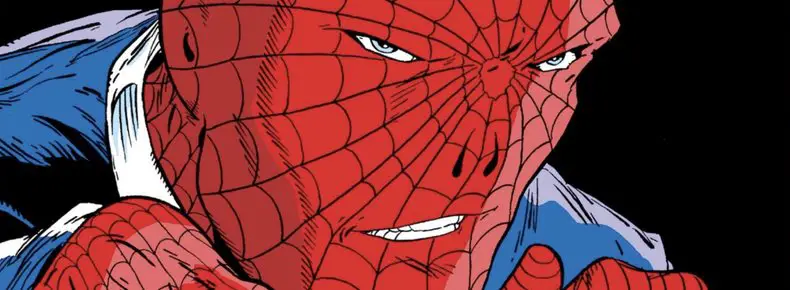The Amazing Spider-Man #307: “The Thief Who Stole Himself”
The Chameleon meets Spider-Man in Chicago and doesn’t get caught. There’s a fun chase sequence, though. And Jonathan Caesar proves, at last, to be the dangerous psychopath we all knew he was.
Lookalike Credits
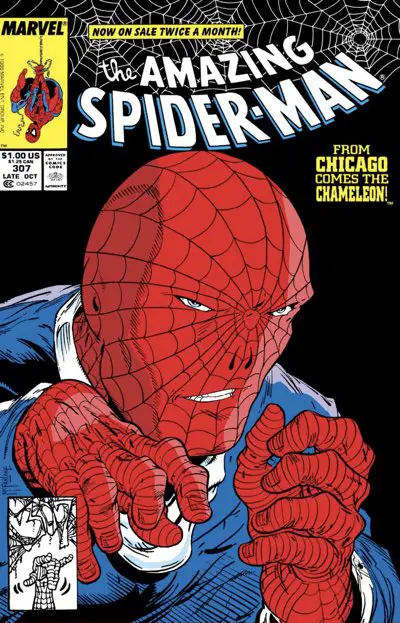
Artist: Todd McFarlane
Colors: Bob Sharen
Letterer: Rick Parker
Publication Date: June 28, 1988
They Don’t Make Them Like This Anymore
I don’t review comics like this anymore. I’m a bit rusty. It’s a completely different story structure, and it took me ten issues or so to figure it out.
European albums are complete packages. Sometimes, there’s a story that goes on for three or six albums, but each book is complete in and of itself. Everything is focused on the story at hand.
In the post-2000 comics era, everything was written for the trade. Stories ran six issues. While storylines might have larger arcs, there was always a certain sense of completion every six issues.
This is when plot summaries stopped happening inside individual comics. They would be awkward in the collected edition that these issues were truly meant for. You shouldn’t have to explain to a reader holding a 144-page trade what’s going on in the story every 22 pages when they likely are reading the book all in one session, or at least in a short enough time span to keep everything in their heads.
Monthly serialized comics from 1988 through 1991, which is what The McSpidey Chronicles follows, is a whole different beast. It’s much closer to an actual soap opera. Stories weave in and out. They can even crossover between the multiple Spider-Man titles that are running at the same time. A supporting character in “Amazing” was a star character in “Web of” a couple of months ago, and you might reference that story here.
Mostly, though, a 22-page comic of the era feels like a collection of mostly random scenes that carry the serialized subplots along. They’re building up steam until they break through and become the main plotline. It’s an effective storytelling style that will bring people back month after month. There’s always an open-loop or two that might just close next month. You don’t want to miss it!
To make the issue feel satisfying, about half of the issue is dedicated to one main plot that will inevitably end up in a violent confrontation between Spider-Man and a villain.
I’m not complaining about this, by the way. These are the books I grew up reading and enjoyed. I still do enjoy the experience today, mostly because I can read them in bulk and get through the long-running threads quicker.
As a reviewer, though, it’s tricky. I’m trying to figure out how to balance covering all of the “important stuff” while not making these reviews sound like I have the attention span of a gnat.
If you think I’m leaving important stuff out, I’m not — I’m just saving it for when it gets important. I think.
Pacing Problems?
That said, this book feels oddly off-balance to me. I originally described it as a pacing problem when I first reviewed the issue, but that’s not exactly it.
Rather, I think the way the scenes flip back and forth, particularly in the first half of the book, isn’t very satisfying. The book ends strongly between the big Chameleon/Spider-Man showdown and the end tag to kick off the storyline for next issue, but the front half of the issue never gets going for me.
The first six pages are various bits of Peter and Mary Jane’s life. They’re going food shopping, Jonathan Caesar invites them to dinner, Peter suddenly is in Chicago sight-seeing and then does a book signing. It’s all nice little moments, but they don’t add up to much. Plus, we’ve been down this road for the last couple of issues already — Peter visits a city, sees a landmark, has a weird moment at a signing.
It’s a collection of scenes, none of which feel very dramatic or interesting.
Introducing The Chameleon
After that section, we get to the main plot of the issue. The Chameleon appears! He sits down and thinks about his life and how his powers work. This is a five-page scene designed to give us all the footnotes of where he’s been seen before and how his powers have changed over the years.
It’s a necessary bit of exposition so we can understand how he does what he does in the action section of the second half of the book. But it takes up too much space to tell us some stuff. Nothing actually happens.
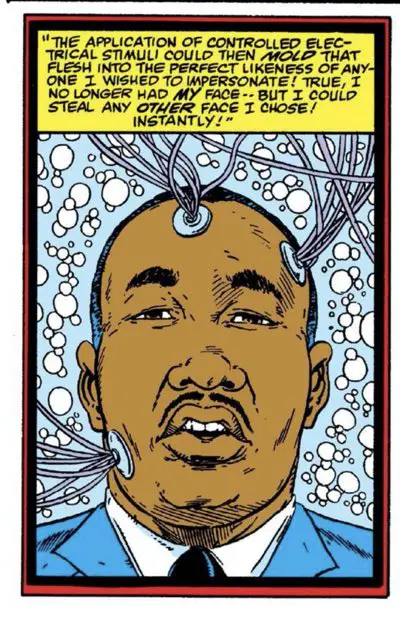
Sure, it’s great that Todd McFarlane can show off his caricature skills on Martin Luther King Jr. and — well, that’s about it. The rest of the sequence is the Chameleon sitting down and thinking and putting VHS tapes into his VCR to watch classic horror movies.
No, but seriously, after bad outings on Johnny Carson and Paul Shaffer, it’s great to see McFarlane’s MLK looking like the real thing.
It all ends with the Chameleon vowing:
“I now have the power, the purpose, and the mobility to bring about a long-delayed destiny — the utter destruction — politically, economically, and strategically — of the United States of America!”
The Chameleon
So, yeah, Chameleon doesn’t think small. He thinks like a Bond villain. Maybe he should audition for “Largo Winch.” (That’ll be my recommendation at the end.)
McFarlane illustrated that last point with a tattered flag hanging over the Capitol Building in flames, a motif he’d return to later in his run. See the cover to “The Amazing Spider-Man” #325, which looks like a more dramatic (and better drawn) recreation of this very panel:
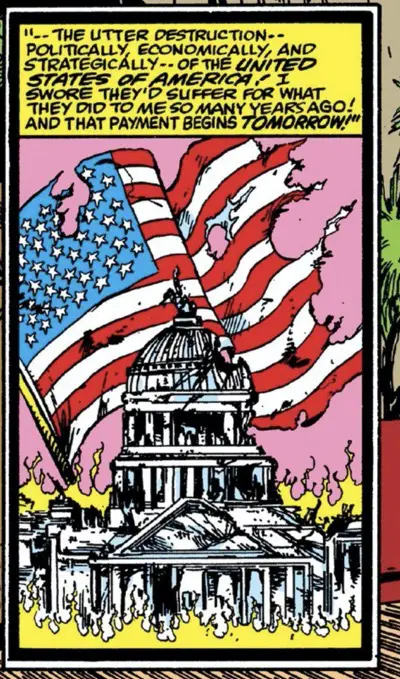
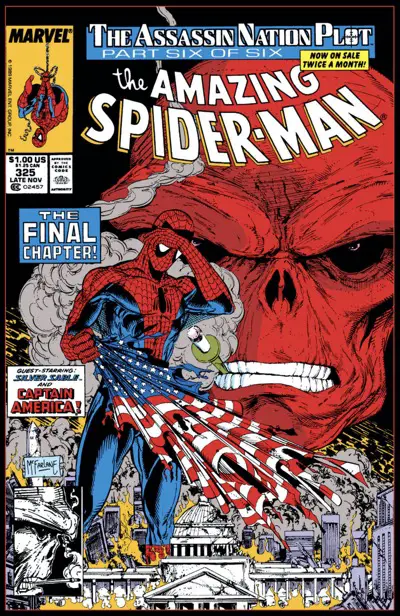
The good news is, everything is now in place for the reason you all came to this issue — the action sequence! It’s a pretty good one, too.
Time for Web-Slinging and Punch Throwing and Bomb Dropping
Peter Parker is at a science expo, where the Mayor has named him an honorary Chicagoan. Peter is more excited to see the guest speaker, though — a scientist doing hush-hush government work on superconductivity. Remember when superconductivity was the next big thing? (Not if you’re younger than 40, you don’t.)
Superconductivity meant that all of our trains would be floating above the rails, not sucked through an underground vacuum tube. End of Pipeline Science Corner. Back to the comics:
Unfortunately, that scientist is the target of the Chameleon, who wants to take his place to get his secrets and sell them to other countries to help destroy America and democracy!
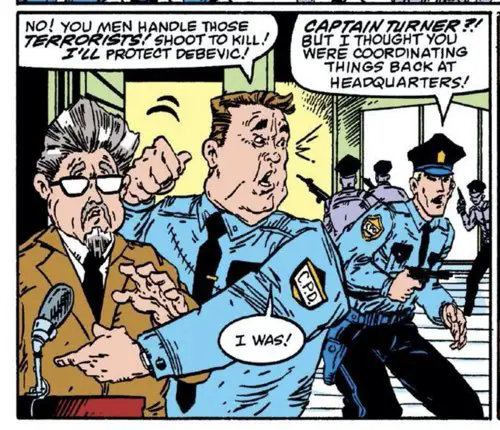
This set piece runs for about eight pages. The Chameleon puts his plan into play by imitating a police officer. Some local goons he’s hired fire shots into the air to start the chaos of stampeding crowds, and the chase is on.
It’s a classic Spider-Man sequence because it starts with Peter Parker needing to ditch the book publicist he’s been hanging out with. After that, it’s a race to suit up and catch up to the Chameleon while saving all the innocent people in the way. Spider-Man has to make concessions as he goes, always to save the innocent at the cost of defeating the Chameleon.
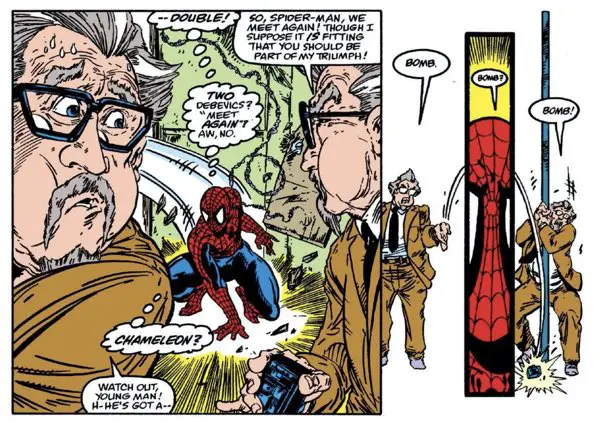
When he finally does catch up to Cham (which is my pet name for him), Cham has already tied up the good doctor and assumed his form. Spider-Man needs to figure out just who to believe. Thankfully, Cham makes it easy for him by dropping a bomb and running off.
Turns out, if you wrap a bomb in enough web fluid, you can save the day and get a nice McFarlane explosion:

Anytime after that that the Chameleon runs out of sight, there’s a chance of him turning into someone else, adding a bit of a thriller element to the whole sequence. He doesn’t repeat himself, and Michelinie keeps the scene moving at a good pace.
In the end, though, Chameleon gets away scot-free, so there’s a bit of a disappointment there that this was all for naught. I suppose Spider-Man did stop Chameleon from his stated goal of replacing the scientist.
I assume Chameleon’s technology doesn’t allow him to remember previous appearances? Or maybe he knew that the scientist would change all his passwords after this attempt on his life? Wait, the Chameleon did some plot exposition on this already:
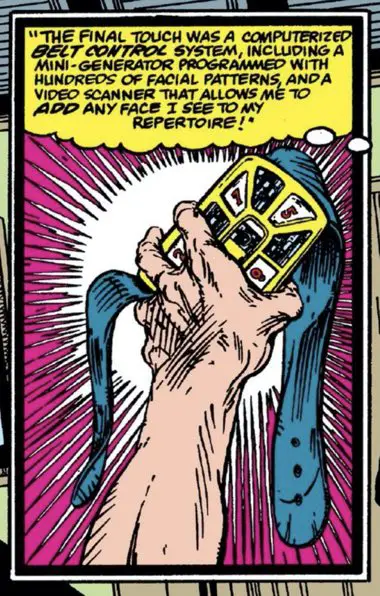
So he can store the scientist’s likeness. The scientist and the country still aren’t out of trouble yet, unless you want to say everyone is on heightened alert after the events of this issue. Would that be enough to thwart a second attempt?
Prelude to the Next Issue
With the main story kinda sorta wrapped up, Michelinie is free to set up the next story for issue #308. This is how the issue winds up:
At the end of the issue, Mary Jane wraps up a swimsuit photoshoot — because, hey two panels of Todd McFarlane drawing a woman in a bikini, right? — before she returns home to discover the creepy Jonathan Caesar waiting in her apartment to kidnap her.
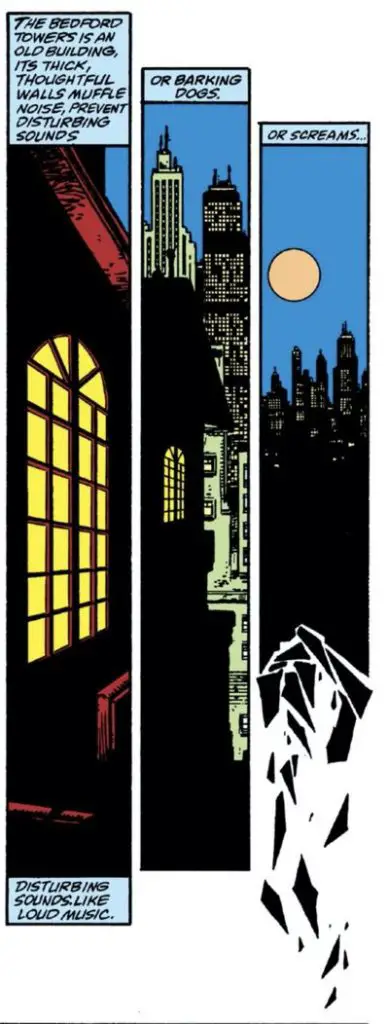
I’ll say this for McFarlane: while the scene is a little cheesy and over the top, he handles it well. Zooming to the outside of the building after the extreme close-up on Caesar’s eye, along with the disintegrating panel at the end really sells the situation without exploiting it.
It’s also a sequence that feels heavily inspired by Frank Miller.
I don’t know that I’ve mentioned Caesar in all his previous appearances. Here’s the rundown:
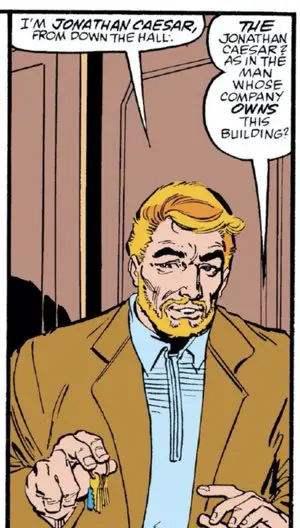
In issue #304, he caught Mary Jane’s keys as she tried to unlock the door to her apartment while juggling the groceries. Introductions are made. She recognizes his name and helpfully (for the reader) points out to him that he owns the building. He says he lives down the hall, admires her work, and would love to have tea sometime.
Yeah, not subtle. The creepiness oozes off him.
Mary Jane immediately, and with a bold-faced font, introduces her husband.
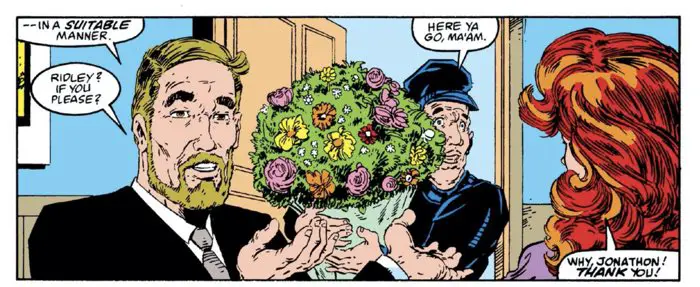
He returned in issue #306 with a bouquet of flowers and an invitation to a party at his place that weekend. He kisses her on the hand and takes his leave.
She attends the party alone while Peter deals with Humbug. She has to fend off a different wannabe suitor there, though Peter arrives just in time to laugh him off. Caesar kicks the jerk out of the party, makes sweet small talk, and then seethes at the camera as he declares, “By Monday night… you’ll be mine!”
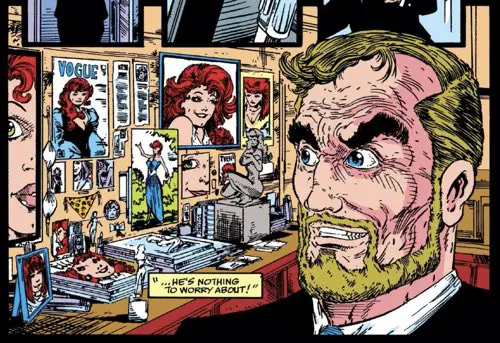
Finally, at the beginning of this issue, we see Caesar’s shrine to Mary Jane in his apartment while he grins menacingly. And then, at the end of the issue and with the help of the old building’s soundproof walls and a couple of burly cigarette-smoking men, he takes her.
Mary Jane can’t find a place to live where bad guys won’t find her. First came that mess at the end of issue #299 with Venom, and now we get the idea that she’s been lured into her current address as a means to an obsessive fan’s end.
I briefly wondered if the events surrounding Rebecca Schaeffer’s obsessive fan and murder was an inspiration for this story. Nope. That happened in July 1989, a year after this issue. In retrospect, I kind of doubt Marvel would have done this storyline soon after that event.
Convention Watch
Peter’s “Webs” book tour was timed so that it always coincided in the comic with the real-world location of a major convention. Peter is in Chicago here in an issue that came out at the end of June.
The Chicago Comicon — which would years later be bought and turned into Wizard World: Chicago — was a mainstay of July 4th scheduling back in the day. It’s where Image had its famous tent signing soon after their formation.
In 1988, it ran from July 1 – July 3 at the Ramada O’Hare in Elk Grove, IL. In the years I attended the convention in Chicago, it had moved to the Rosemont Convention Center in Rosemont, IL.
One unlucky year, I flew into Midway. It’s the kind of airport where you try to keep your head low so it doesn’t hit the ceiling because I’m sure the building was so old that people were 3 inches shorter, on average.
It was at O’Hare one year, though, that a monsoon of a rainstorm shut the airport down for hours. My best memory of that day was seeing Rob Liefeld sitting crosslegged on the floor of the terminal drawing on his lapboard and talking to fans. The comic show never ends!
Felix Watch

Peter has an incident at a book signing that probably came from a personal experience on the part of the comic’s author. It’s another in a streak of bad signing experiences for Peter.
In this particular book signing stop, a hysterical young man who doesn’t even know Peter’s name is seen wearing a Felix shirt.
You get a full three panels of Felix in this issue, which is a new record.
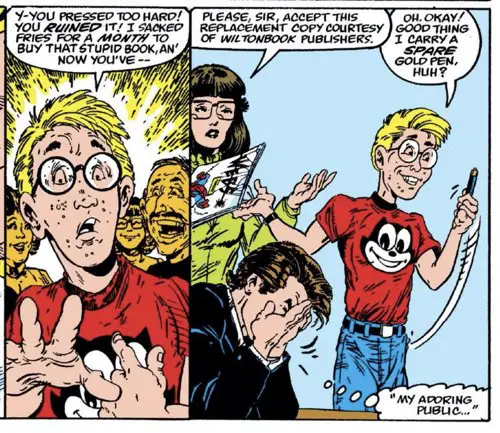
Spawn Watch
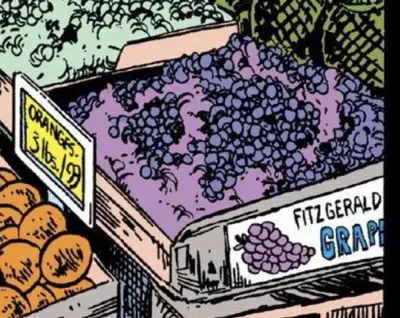
In the pulse-pounding opening scene at the grocery store, I’m guessing the “Fitzgerald Grapes” are named after McFarlane’s friend, Terry Fitzgerald, whose name was borrowed for Spawn’s best friend who’d later go on to marry Wanda and have a child with her. It’s definitely McFarlane’s handwriting on that sign.
Hidden Cover Spiders
McFarlane returned to hiding spiders on the cover for good, starting with this issue.
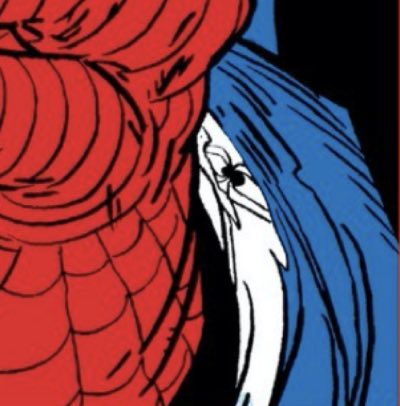
Look at the white cuff of the shirt on Chameleon’s left arm. It’s just to the right of his hand. There’s your spider.
You can see the black and white original art for this cover on Heritage Auctions. They sold it back in 2016.
Reprint Watch
There’s a curious quality to the linework in this issue in the digital reprint and the print Omnibus edition. When you compare it to the original newsprint work, you see that everything feels more saturated.
It’s like they turned the black slider up too high. The inks are too dark and the colors are uniformly darker than the original comics. It gives the art a slightly thicker look. It’s not horrible, but it is noticeable, especially as McFarlane’s inking style uses so many thin lines.
BD Recommendation
If you liked this issue, I have a recommendation for you from the world of les bandes dessinées, or Franco-Belgian comics.

With the Chameleon plotting the overthrow of the American economic and political system, I’m reminded of “Largo Winch,” where stories include secret lairs, macroeconomics, billion-dollar swings of fortune, and some great action sequences. The end of the second book is one of the great chase scenes through the streets of New York City I’ve seen in comics.
But I’d suggest starting with the first book. It’s the “origin” story and a good rambunctious one, at that. It doesn’t feel like the story you need to do to get it out of the way to get to the real stuff. No, this is definitely a case where the origin story feels like just another story in the series in the best possible way.
It’s also a great value for the money. The first two books are a solid 96 pages of story. Set aside 45 minutes or an hour to read each. There’s more story and dialogue on these pages than your usual Marvel/DC book. Yet, they’re still real page-turners, with the best combination of action and high finance.
You can read my review of “Largo Winch” v1 here.
In the Next Issue
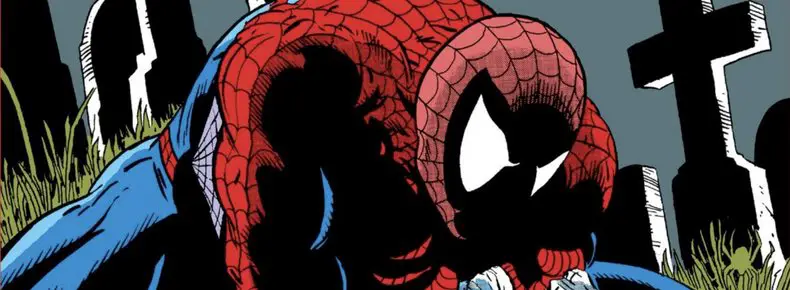
Peter goes looking for Mary Jane and runs across the Taskmaster, a perfect visual for McFarlane’s style.

